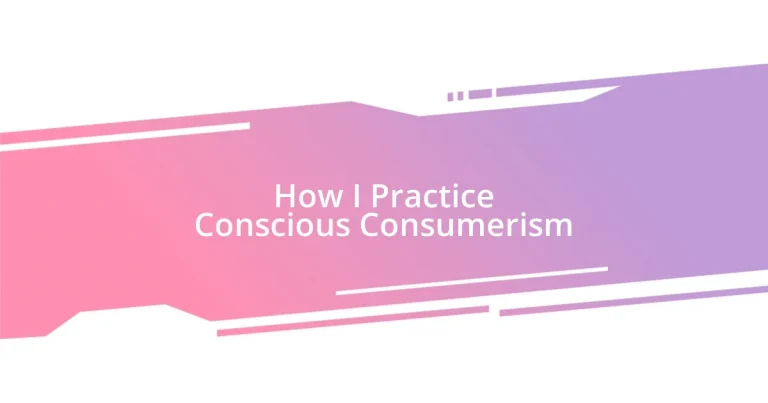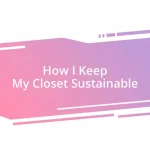Key takeaways:
- Conscious consumerism involves choices that reflect personal values, emphasizing a deeper connection to products and the world.
- Researching brands’ ethical practices and engaging in community initiatives can enhance meaningful consumer experiences.
- Mindful shopping fosters intentional purchasing decisions, prioritizing quality and sustainability while supporting local businesses and advocating for positive change.
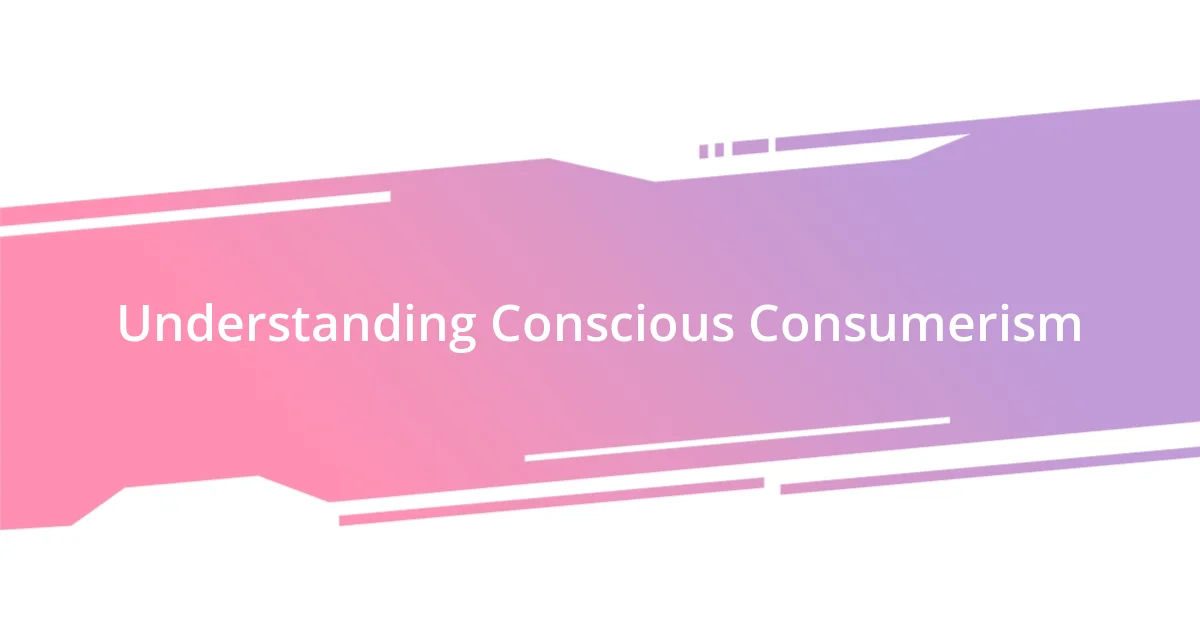
Understanding Conscious Consumerism
Conscious consumerism is about making choices that reflect our values and beliefs. For instance, I remember the first time I consciously chose to buy from a local farmer’s market instead of the supermarket. It felt good knowing that my decision supported local agriculture and reduced environmental impact.
When I think of conscious consumerism, I often wonder if we fully grasp the power of our purchases. Each time we buy something, it’s not just a transaction; it’s a vote for the kind of world we want to see. This realization struck me hard when I discovered that my favorite clothing retailer had questionable labor practices. It made me rethink where I spent my money.
Engaging in conscious consumerism isn’t just about being ethical; it can also be a fulfilling journey. I’ve learned that researching brands and understanding their impact often leads to discovering exciting new products that align with my values. When was the last time a mindful purchase not only made me feel good but also connected me to a larger community? It’s these moments of connection that enrich my life and enhance my overall well-being.
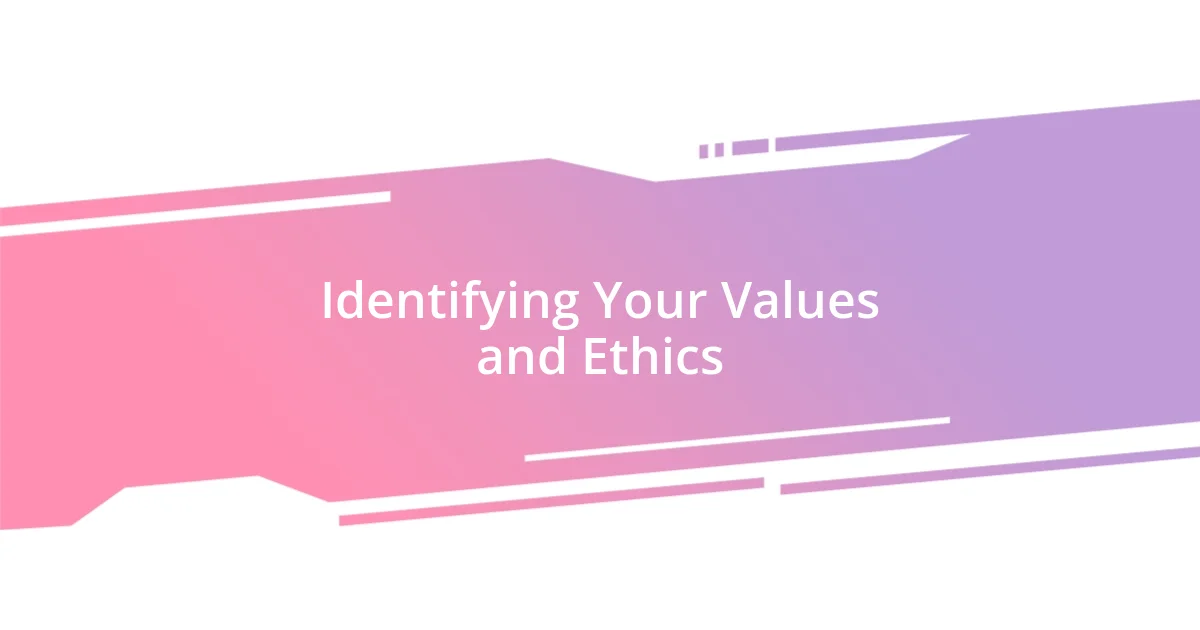
Identifying Your Values and Ethics
Identifying my values and ethics has been an eye-opening process. I vividly remember a time when I decided to forgo traditional brand names in favor of B Corps—companies certified for their social and environmental performance. That choice wasn’t just about saving money; it was a commitment to supporting businesses that share my values of sustainability and fair labor practices. Every time I make a purchase now, I find myself reflecting on how that choice aligns with who I want to be in the world.
To help identify your own values and ethics in consumerism, consider the following:
- What causes resonate with you? (e.g., environmental sustainability, animal welfare, social justice)
- How do you feel about the companies and products you currently support?
- Which brands inspire you with their commitment to ethical practices?
- Are there specific communities or causes you want your purchases to uplift?
- What personal experiences have shaped your purchasing decisions in the past?
By pondering these questions, you can begin to align your consumer choices with your core values.

Researching Brands and Products
When researching brands and products, I find that diving deep into a company’s ethos really informs my choices. I recall a time when I stumbled upon a beauty brand that highlighted its commitment to cruelty-free practices while giving back to animal shelters. That sense of purpose resonated with me so much that it turned a simple purchase into an act of solidarity. I now make it a priority to investigate companies’ missions and values before making any decisions, as it brings me a sense of community and shared beliefs.
I’ve learned to utilize resources like ethical review websites and consumer reports, which often break down the impact of brands on various social and environmental fronts. For instance, when I learned that a popular tech brand had a comprehensive recycling program, it opened my eyes to how my love for gadgets could also support sustainability. Conducting thorough research has transformed my shopping habits into something more meaningful, fostering a deeper connection to the products I purchase.
One of my go-to strategies is to compare brands side by side. Table formats can simplify that process, making it easier to spot the differences quickly. Here’s a small comparison table that helps illustrate my approach to assessing brands:
| Brand | Ethical Practices |
|---|---|
| Brand A | Fair trade sourcing, carbon-neutral |
| Brand B | Eco-friendly materials, animal welfare certified |
| Brand C | Charitable contributions, sustainable production |
By developing these research habits, I’ve not only become a more informed consumer but also a more engaged member of my community. Every purchase now feels less transactional and more like a meaningful investment in the kind of world I want to support.
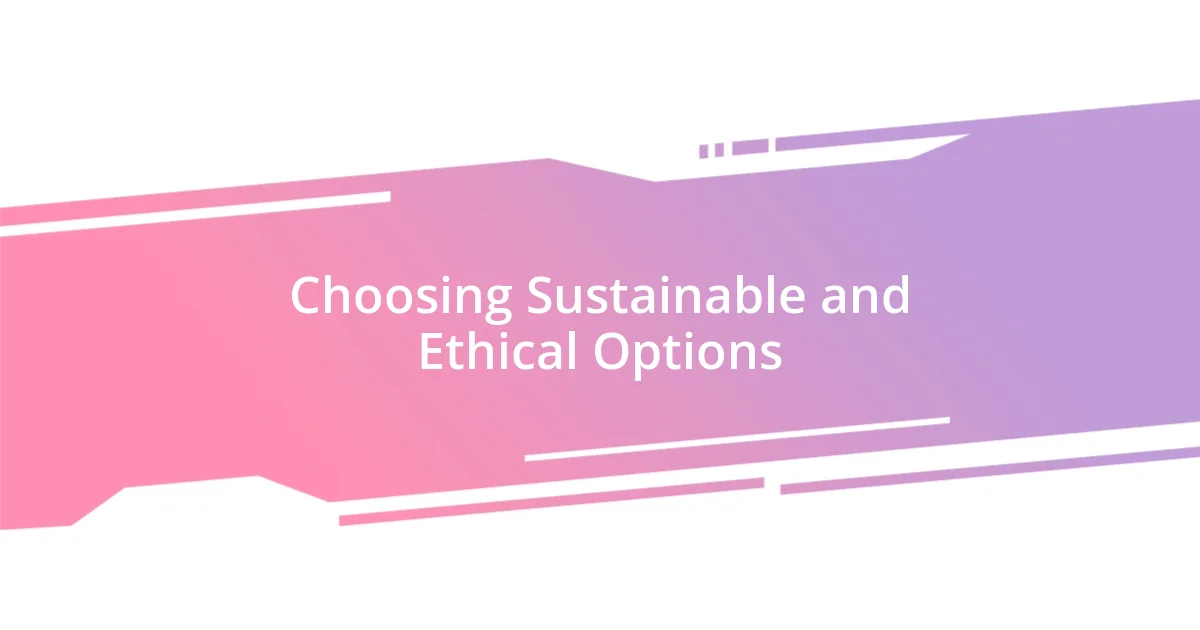
Choosing Sustainable and Ethical Options
Making choices that align with sustainability and ethical practices can sometimes feel overwhelming, but I’ve found that small changes can lead to impactful decisions. For instance, when I started opting for clothing made from organic materials or recycled fabrics, it was as if I’d unlocked a new level of awareness. Each time I wear those items, I feel a genuine connection to the planet, knowing I’ve chosen items that contribute to reducing waste and conserving resources.
One memorable experience was when I attended a local farmers’ market for the first time. The vibrant atmosphere and direct connection to the growers shifted my perspective entirely. I remember chatting with a farmer about his organic practices and the love he pours into his crops. It was this personal interaction that made me appreciate the ethics behind my food choices. It’s these experiences that truly enrich my life because they remind me of the human stories woven into the products I choose.
When I think about the importance of ethics in my purchases, I often ask myself: How can my choices uplift my community? I remember discovering a local coffee shop that sources its beans from fair-trade farmers, giving me a sense of purpose with every sip. Knowing that my coffee habit supports farmers and their families makes enjoying that morning brew all the more rewarding. It’s moments like these that drive home the idea that consumerism can be a powerful tool for positive change.
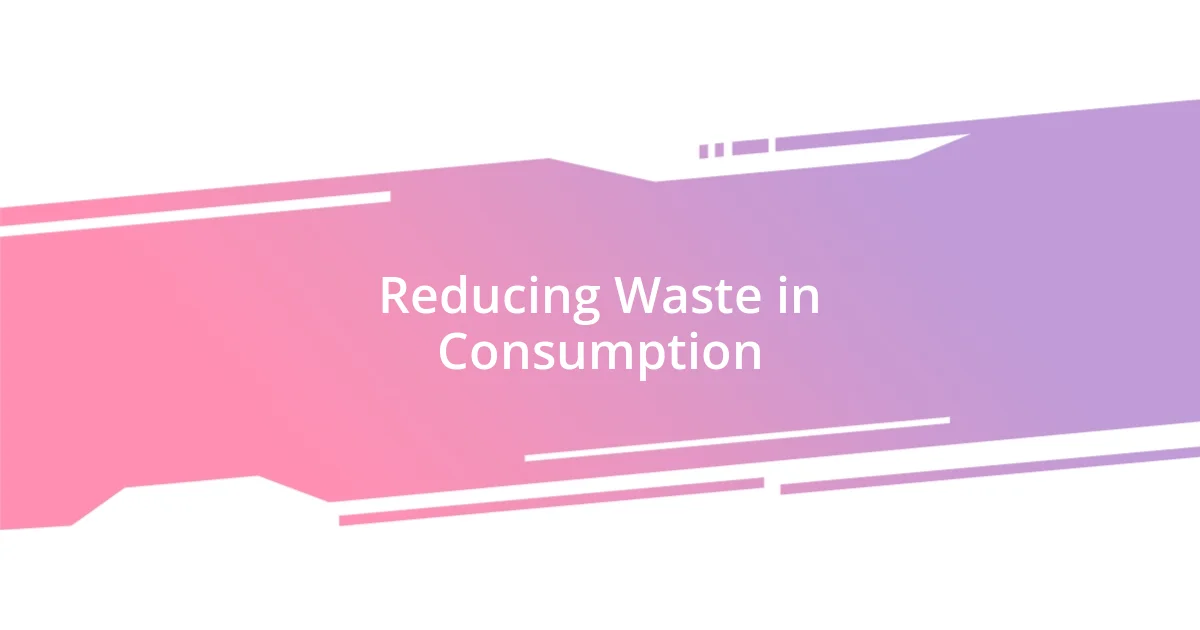
Reducing Waste in Consumption
Reducing waste in consumption is something I’ve been actively working on, and it often starts with a simple yet powerful mindset shift: less is more. I remember walking through my home one day, realizing how many plastic items I had accumulated over the years. It struck me that there’s a deeper change I could make by minimizing my reliance on single-use plastic products. Now, I carry a reusable tote bag everywhere, not just for groceries but also for spontaneous shopping trips. It has become a habit that feels good and reduces waste simultaneously.
I’ve also embraced the practice of repairing instead of replacing. This is an area where I’ve seen significant change in my consumption habits. There was a time when a torn shirt or a cracked phone screen meant a quick trip to the store. Now, I’ve learned to sew those little tears or fix minor electronic issues myself. It’s not just about saving money; it’s incredibly gratifying to breathe new life into something that might have otherwise ended up in a landfill. Have you ever tried it? You’d be surprised how satisfying it feels to give an old item a second chance.
Another change I’ve made is to consciously choose bulk or package-free products. I recall a recent trip to the local co-op where I filled my jars with grains, nuts, and spices. Not only did this approach cut down on excess packaging, but I also enjoyed the experience of curating my own selection. It’s almost like shopping is transformed into a scavenger hunt, one that leads to a more thoughtful, waste-conscious outcome. Each visit reaffirms my commitment to reducing waste, and I can’t help but wonder how many others are missing out on this rewarding experience.
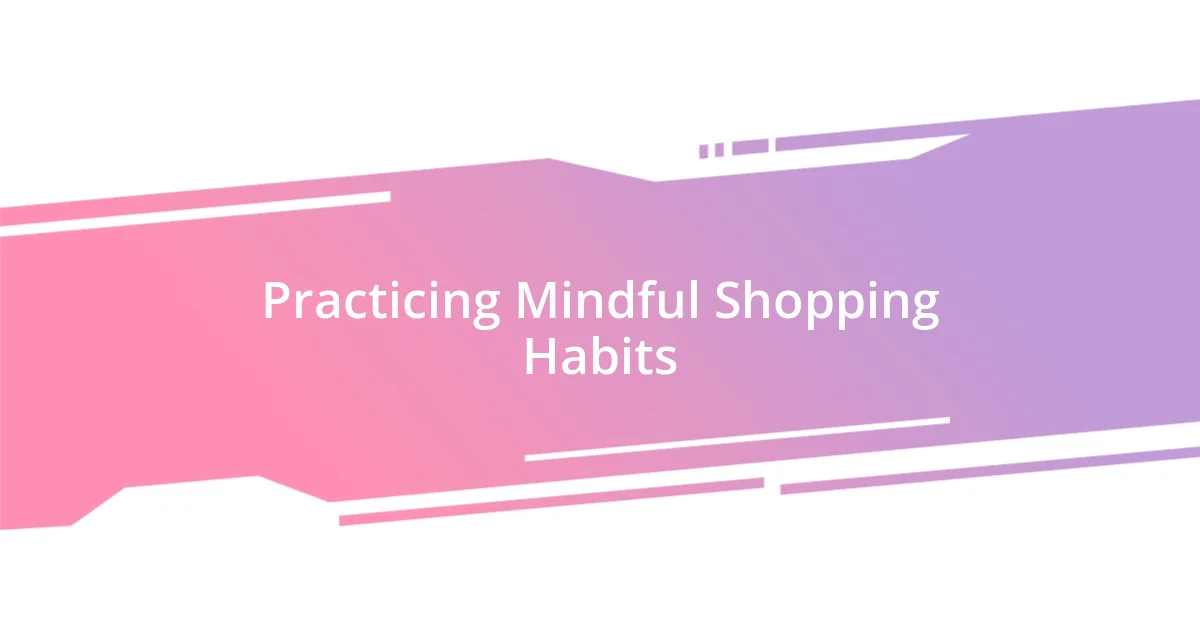
Practicing Mindful Shopping Habits
Mindful shopping habits start with being intentional about what I buy. I often pause before any purchase, asking myself questions like, “Do I really need this?” or “How will this fit into my life?” This simple practice helps eliminate impulse buys and encourages me to invest in quality over quantity. Recently, when I was about to buy a trendy gadget, I took a moment to consider its long-term usefulness. I ultimately decided against it, finding more value in experiences than in material possessions.
Additionally, I’ve found that keeping a shopping list not only streamlines my trips but also reflects my mindful approach. I include items that serve a purpose and contribute positively to my life. Last week, I set out to buy ingredients for a homemade meal instead of picking up takeout. Shopping with intention turned what could be a routine chore into a delightful exploration of flavors. As I delicately chose fresh vegetables and unique spices, I realized how each decision was bringing joy back into the act of shopping.
Engaging in mindful consumerism also means supporting local businesses whenever possible. I vividly recall walking into a small bookstore and feeling that instant connection with the owner, who shared my love for literature. I left not just with a new novel but with a warm sense of community. Have you ever considered how a small purchase can create ripples of support that strengthen your local economy? It truly makes shopping feel like a meaningful act rather than just a transaction.
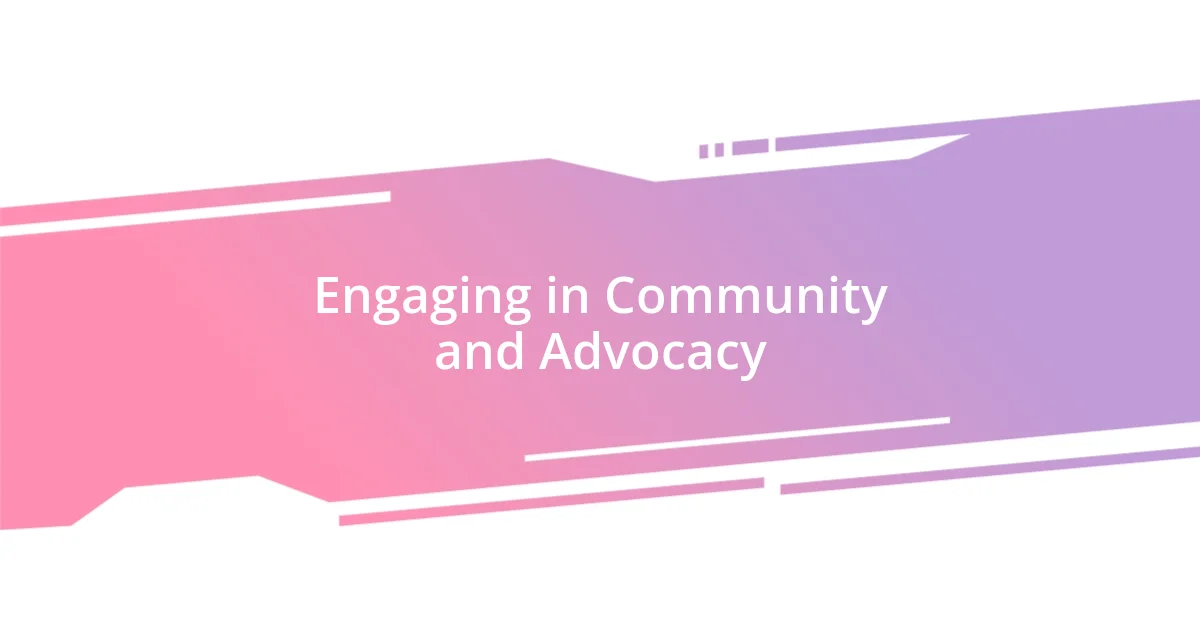
Engaging in Community and Advocacy
Engaging with my community has opened my eyes to the full impact of conscious consumerism. A few months ago, I joined a local advocacy group focused on sustainable practices. The energy in those meetings was electric; people shared their stories of change and collectively brainstormed actions. It’s inspiring to see how local initiatives can lead to meaningful change, reinforcing the idea that we’re all in this together. Have you ever felt that rush of motivation from being in a supportive group? It’s truly transformative.
I’ve also taken part in community clean-ups, where I witnessed firsthand the difference that collective efforts can make. As we picked up litter in a nearby park, I felt a deep sense of pride—not just in our immediate actions, but in the conversations that sparked around the importance of choosing sustainable products. Discussions about where to shop and how to advocate for better waste management policies enriched our connections. There’s nothing quite like the camaraderie that comes from working together toward a common goal.
Moreover, I find that connecting with local artisans and farmers at community markets elevates my shopping experience. I still remember the first time I met a farmer who grew organic vegetables just a few miles from my home. Hearing her passion and commitment to sustainable farming practices made my purchase feel significant. It reminded me that every choice matters, not just for me but for the people who pour their hearts into their work. Have you ever spoken to a vendor and felt that instant connection? It’s these moments that deepen my commitment to community engagement and advocacy, making me realize how our choices can uplift those around us.












